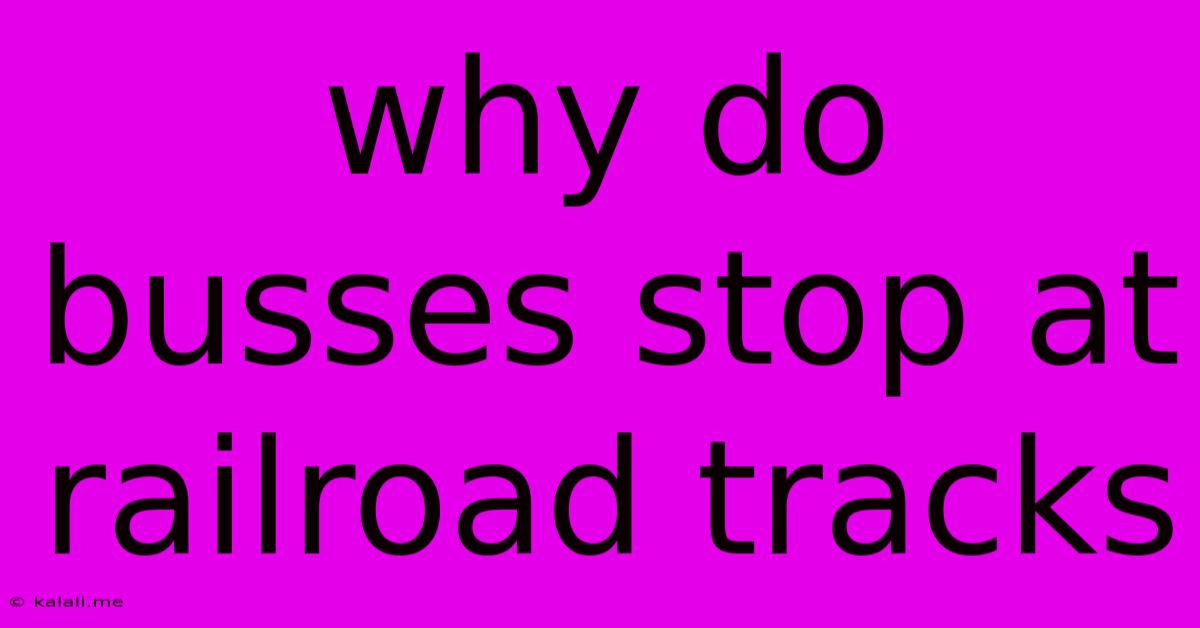Why Do Busses Stop At Railroad Tracks
Kalali
Jun 08, 2025 · 3 min read

Table of Contents
Why Do Buses Stop at Railroad Tracks? A Comprehensive Guide to Rail Crossing Safety
Buses stopping at railroad crossings might seem like an unnecessary inconvenience, especially when there's no immediate sign of an approaching train. However, this practice is a crucial safety measure designed to protect passengers and prevent potentially devastating accidents. This article delves into the reasons behind this seemingly simple act, exploring the various contributing factors and highlighting the importance of rail crossing safety.
Understanding the Risks of Rail Crossings
Trains are significantly heavier and faster than buses, making collisions incredibly dangerous. The sheer momentum of a train makes it nearly impossible to stop quickly, leading to catastrophic consequences in the event of a collision. Even at low speeds, a collision between a bus and a train can result in serious injuries and fatalities. Factors contributing to the risk include:
- Limited Visibility: Often, the view of approaching trains is obstructed by vegetation, buildings, or the curvature of the track. This lack of visibility increases the danger significantly.
- Train Speed and Braking Distance: Trains require a considerable distance to stop, even when braking is initiated promptly. This long braking distance makes quick evasive maneuvers ineffective.
- Bus Size and Maneuverability: Buses are large and relatively slow to react, limiting their ability to quickly escape a dangerous situation at a rail crossing.
- Passenger Safety: The primary concern is always the safety of passengers onboard the bus. Stopping allows the driver ample time to assess the situation and ensure a safe crossing.
Why the Stop is Mandatory (and Not Just a Suggestion)
The practice of buses stopping at railroad tracks is often mandated by company policy, local regulations, or even state laws. These regulations are implemented to:
- Minimize Accidents: The most significant reason is to drastically reduce the likelihood of collisions. A complete stop allows the driver a clear view of the tracks, enabling them to proceed safely only when no train is approaching.
- Comply with Regulations: Many jurisdictions have specific laws or regulations requiring buses to stop at railroad crossings, especially in areas with poor visibility or a history of accidents. Failure to comply can result in hefty fines and legal repercussions.
- Instill Safe Driving Practices: The mandatory stop reinforces safe driving practices and reinforces the driver's awareness of potential hazards at rail crossings.
- Protect Passengers and Property: Preventing accidents protects the lives of passengers, the driver, and pedestrians, as well as preventing damage to the bus and other property.
Beyond the Stop: Other Safety Measures at Rail Crossings
While stopping is crucial, it's just one part of a comprehensive safety strategy. Other important aspects include:
- Proper Driver Training: Bus drivers receive specialized training on safely navigating railroad crossings, including how to assess risk, react to approaching trains, and handle unexpected situations.
- Regular Maintenance of Buses: Ensuring the bus is in optimal condition contributes to its responsiveness and maneuverability, improving the driver's ability to react quickly.
- Improved Infrastructure: Advancements in rail crossing safety technology such as improved signals, gates, and warning systems enhance overall safety.
In conclusion, the practice of buses stopping at railroad tracks is not an arbitrary measure. It's a vital safety precaution grounded in the inherent dangers of rail crossings and the responsibility to protect passengers and prevent potentially catastrophic accidents. By understanding the risks and the reasons behind this seemingly simple action, we can all contribute to safer roads and a reduction in rail crossing incidents.
Latest Posts
Latest Posts
-
Is It Illegal If My Address Is Wrong
Jun 08, 2025
-
Who Goes First At A Stop Sign
Jun 08, 2025
-
Air Conditioner Cant Keep Up On Hot Days
Jun 08, 2025
-
Why Is Facebook Logging Me Out
Jun 08, 2025
-
How Long Is Pork Loin Good In The Fridge
Jun 08, 2025
Related Post
Thank you for visiting our website which covers about Why Do Busses Stop At Railroad Tracks . We hope the information provided has been useful to you. Feel free to contact us if you have any questions or need further assistance. See you next time and don't miss to bookmark.